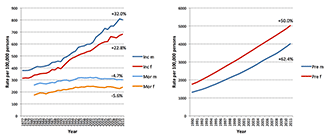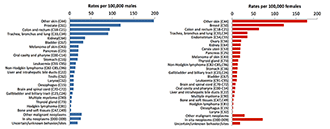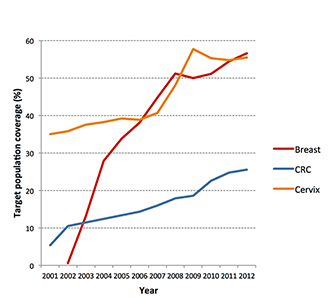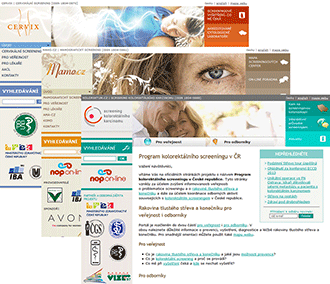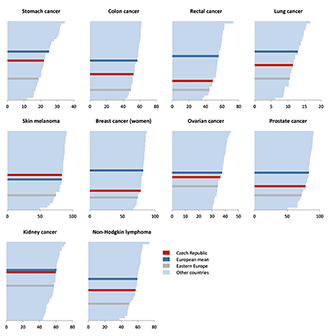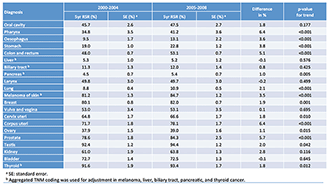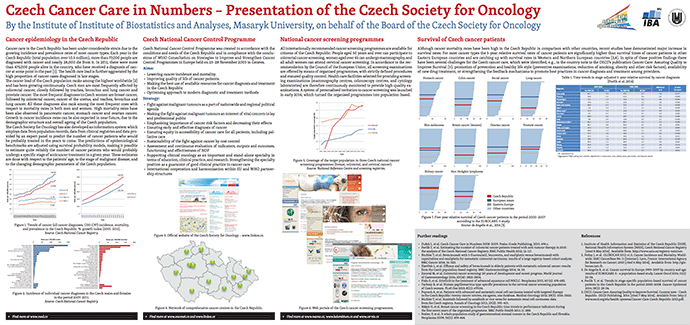Articles
27. 10. 2015 Cancer in the older population of the Czech Republic
Population ageing has become a challenge to cancer care in developed countries. Particularities of the older population must be taken into account when considering cancer treatment. However, there is a lack of consensus on guidelines for this population due to the underrepresentation of older patients in clinical trials.
15. 1. 2014 Personalised invitations of Czech citizens to cancer screening programmes
In January 2014, a project of personalised invitations for cancer screening programmes was launched in the Czech Republic. In particular, citizens are invited to participate in colorectal cancer screening (men and women), as well as breast cancer screening and cervical cancer screening (women). Personalised invitations are aimed at citizens who have not participated in cancer screening programmes in the long term, and therefore are at a higher risk of developing cancer. The project is expected to increase participation rates in Czech cancer screening programmes.
» Archive
Czech Cancer Care in Numbers: a brief summary
A compact description of cancer care in the Czech Republic was presented at the ESMO 2014 Congress in Madrid, Spain. The Czech Society for Oncology and the Institute of Biostatistics and Analyses of the Masaryk University worked together to highlight the alarmingly growing cancer burden of the Czech population, to explain the current National Cancer Control Programme and ongoing cancer screening programmes, and to comment the latest survival rates of Czech cancer patients.
Cancer epidemiology in the Czech Republic
Cancer care in the Czech Republic has been under considerable strain due to the growing incidence and prevalence rates of most cancer types. Each year in the Czech Republic (total population over 10.5 million), more than 77,000 people are diagnosed with cancer and nearly 28,000 die from it. In 2011, there were more than 475,000 people alive in the country, who have received a diagnosis of cancer at some point in the past [1]. The health care load is further aggravated by the high proportion of cancer cases diagnosed in late stages.
The cancer load of the Czech population ranks among the highest worldwide [2] and has been growing continuously. Czech men are most frequently affected by colorectal cancer, closely followed by trachea, bronchus and lung cancer and prostate cancer. The most frequent diagnoses in Czech women are breast cancer, followed by colorectal cancer, cancer of the uterus, and trachea, bronchus and lung cancer. All these diagnoses also rank among the most frequent ones with respect to mortality rates in both men and women. High mortality rates have been also observed in pancreatic cancer, stomach cancer and ovarian cancer. Growth in cancer incidence rates can be also expected in near future, due to the demographic structure and overall ageing of the Czech population.
The Czech Society for Oncology has also developed an information system which employs data from population records, data from clinical registries and data provided by an expert panel to predict the number of cancer patients who would be probably treated in the years to come. The predictions of epidemiological benchmarks are adjusted using survival probability models, making it possible to estimate quite reliably the number of cancer patients who would probably undergo a specific stage of anticancer treatment in a given year. These estimates are done with respect to the patients' age, to the stage of malignant disease, and to the changing demographic parameters of the Czech population.
Czech National Cancer Control Programme
Czech National Cancer Control Programme was created in accordance with the conditions and needs of the Czech Republic and in compliance with the conclusions of WHO Consultation on Strategies to Improve and Strengthen Cancer Control Programmes in Europe held on 25–28 November 2003 in Geneva.
Aims:
- Lowering cancer incidence and mortality.
- Improving quality of life of cancer patients.
- Making the best use of available resources for cancer diagnosis and treatment in the Czech Republic
- Optimising approach to modern diagnostic and treatment methods
Strategy:
- Fight against malignant tumours as a part of nationwide and regional political agenda
- Making the fight against malignant tumours an interest of vital concern to lay and professional public
- Emphasising importance of cancer risk factors and decreasing their effects
- Ensuring early and effective diagnosis of cancer
- Ensuring equity in accessibility of cancer care for all patients, including palliative care
- Sustainability of the fight against cancer by cost control
- Assessment and continuous evaluation of indicators, outputs and outcomes, functioning and effectiveness of NOP
- Supporting clinical oncology as an important and stand-alone specialty in terms of education, clinical practice, and research. Strengthening the specialty position as a guarantor of good clinical practice in cancer care
- International cooperation and harmonization within EU and WHO partnership structures
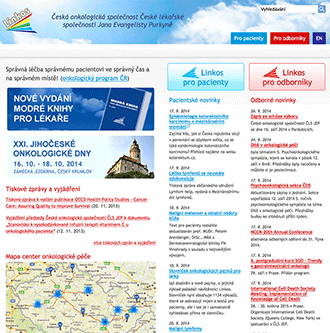 |
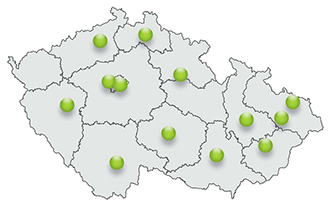 |
| Figure 3: Official website of the Czech Society for Oncology (www.linkos.cz). | Figure 4: Network of comprehensive cancer centres in the Czech Republic. |
National cancer screening programmes
All internationally recommended cancer screening programmes are available for citizens of the Czech Republic. People aged 50 years and over can participate in colorectal cancer screening, women aged over 45 can undergo mammography, and all adult women can attend cervical cancer screening. In accordance to the recommendation by the Council of the European Union, all screening examinations are offered by means of organised programmes, with strictly defined procedures and ensured quality control. Health care facilities selected for providing screening examinations (mammography centres, colonoscopy centres, and cytology laboratories) are therefore continuously monitored to provide high-quality examinations. A system of personalised invitation to cancer screening was launched in early 2014, which turned the organised programmes into population-based ones.
Survival of Czech cancer patients
Although cancer mortality rates have been high in the Czech Republic in comparison with other countries, recent studies have demonstrated major increase in survival rates. For most cancer types the 5-year relative survival rates of cancer patients are significantly higher than survival times of cancer patients in other Eastern European countries and are catching up with survival rates in Western and Northern European countries [3,4]. In spite of these positive findings there have been several challenges for the Czech cancer care, which were identified, e.g., in the country note to the OECD’s publication Cancer Care: Assuring Quality to Improve Survival [5]: promotion of prevention and healthy life style (preventive examinations, reduction of smoking, obesity and other risk factors), availability of new drug treatment, or strengthening the feedback mechanisms to promote best practices in cancer diagnosis and treatment among providers.
International publications referring to Czech cancer care
Results of the National Cancer Control Programme (NCCP) are published in medical journals and in other professional literature. For more information, visit Selected publications referring to Czech cancer care.
References
- Institute of Health Information and Statistics of the Czech Republic (IHIS). National Health Information System (NHIS), Czech National Cancer Registry [cited 8 May 2014]. Available from: http://www.uzis.cz/registry-nzis/nor.
- Ferlay J, et al. GLOBOCAN 2012 v1.0, Cancer Incidence and Mortality Worldwide: IARC CancerBase No. 11 [Internet]. Lyon, France: International Agency for Research on Cancer; 2013 [cited 6 May 2014]. Available from: http://globocan.iarc.fr.
- De Angelis R, et al. Cancer survival in Europe 1999–2007 by country and age: results of EUROCARE-5 – a population-based study. Lancet Oncol 2014; 15(1): 23-34.
- Pavlik T, et al. Trends in stage-specific population-based survival of cancer patients in the Czech Republic in the period 2000-2008. Cancer Epidemiol 2014; 38(1): 28-34.
- OECD. Cancer Care: Assuring Quality to Improve Survival. Country note – Czech Republic. OECD Publishing, 2014 [cited 7 May 2014]. Available from: http://www.oecd.org/els/health-systems/Cancer-Care-Czech-Republic-2013.pdf.
Poster presented at ESMO 2014
You can download the poster as a ![]() PDF file (1.2 MB).
PDF file (1.2 MB).
8. 10. 2014 IBA MU


